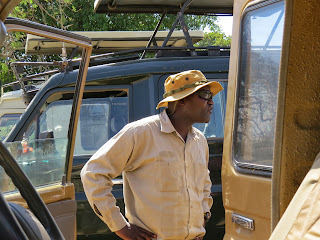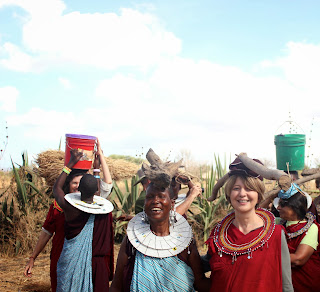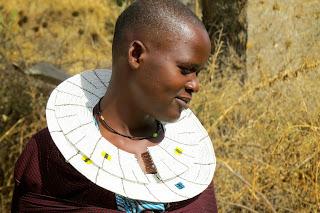Today we ride with
Dominick. He speaks five languages and can guide fluently in three, (French, English, Spanish). Actually,
he could guide in 4 but there isn’t much demand for Swahili language
safaris…yet. Many of his sentences are punctuated with a melodic, emphatic “ye-ah?”
 |
| Dominick |
 |
| More Dom |
The Big Five:
Elephant
Lion
Rhinoceros
Leopard
Cape Buffalo
The big five is a list
once created by big-game hunters of the most difficult animals to hunt on foot.
The term was co-opted by safari operators as the “must-see” animals. We’re
buying into the list idea and definitely hope to see them all.
Dom introduces us to
the little five; all animals connected to the big five by their names.
The Little Five:
Elephant Shrew
Ant-Lion
Rhinoceros Beetle
Leopard Turtle
White Headed Buffalo
Weaver
Not an imposing list.
But, we’ll keep it in mind.
Today we’re traveling towards the Serengeti on a mix of paved
and rutted roads. Dom tells us there is so much road-induced jostling they
can’t rely on the gas gauge needle. Instead, each day they set the odometers to
zero and calculate by mileage how much gas they’re using.
Even on the paved
portions he’s forced to maneuver over speed bump after speed bump. When this
portion of the road was unpaved people could see and hear cars coming from a
long distance. Once it was paved the cars came quickly and quietly and
individuals were struck while trying to cross. People staged a protest by
laying in the road and eventually forced the government to place speed bumps in
populated areas.
For every driving
infraction the police will charge you $20 per offense.
80% of the people in
Tanzania live in rural areas on $1 a day or they barter and live without money.
A successful farmer makes @ $10,000 a year.
There are also, for
real, zebra crossings. If they need to get to the other side of the road, they
just go. We are entertained.
We also stop when Dom
spots a leopard turtle in the road. It’s a big beautiful creature with
leopard-like spots on its shell. Dom is about to rescue it from the road and
redirect it back to safety, but as soon as he stops the truck several little
boys come out of hiding and scoop the turtle up. Then they ask for money to
allow us to take photos. Not wanting to encourage this devilish (but
enterprising) deed, we move on.
Chief Labulu welcomes
us to a Maasai village. He is a young chief who’s earned his respected position
because he is an effective communicator and mediator and also because he once killed
a lion single-handedly.
 |
| Chief Labulu |
Each village represents
a family. There is one hut for the male and one hut for each of his wives. The
compound is fenced with sisal plants. The spikey sword-shaped leaves not only provide
a barrier against unwanted visitors but their fiber is super strong. It is
dried and woven into rugs and rope and is also used as a medicine.
We are greeted by a
line of women who come dancing and singing from the far side of the compound. They
are dressed in maroon robes and wear beaded neck discs. Thrusting their
shoulders makes the discs bounce.
They wrap the women in
our group in lively red sari-like robes, cinched at the waist. Gorgeously
beaded neck discs add a finishing touch. They invite us to dance with them and
we perform in an enthusiastic but ultimately pathetic effort.
The men then perform their leaping dance. They jump into the air from a standstill. The higher the leap, the higher the admiration.
 |
| Maasai Leaping Dance |
 |
| So You ThinkYou Can Leap? |
Their round huts are
plastered with a mix of cow dung, soil and ash and have dry thatched roofs. We
are invited (women only) to try our hand at adding dried straw to a rooftop and
to smear a wall with dung. Why would we refuse? Afterwards we are treated to a
cleanup session, our hands are scrubbed and our nails cleaned with a switch of
straw. The Maasai women’s nails are worn down to nothing and their hands are coarse
and work-roughened.
 |
| Thatch Work |
 |
| Drying in the Sun |
 |
| Raw Materials |
 |
| Stucco Work |
 |
| Maasai Manicure |
 |
| Learning to Use Our Heads |
The huts have a living
area with a wood fired cooking stove and benches. A wall divides off a sleeping
area. Baby animals are brought into the living area at night for protection.
 |
| Cookstove Chimney |
 |
| Hut Ceiling |
 |
| Ombeni Explains How This Milk-Filled Gourd is Shaken to Make Butter |
 |
| View Through the Hut Window |
In the Maasai culture
men have lots of free time. Women do all of the work. Current wives often
suggest wife candidates hoping they will be added to the family and share in
the workload. A man pays a dowry, (cattle) for a wife. The dowry can be paid
over time.
Young boys tend the
cattle. When a Maasai meets another Maasai the first two questions asked are:
“How are the kids?” and “How are the cows?” A strong indicator of what is
important in their pastoral lives.
Maasai don’t celebrate
birthdays. If you ask their age they will give you an older age so they get
more respect. They have great deference for old people, as they are ready to go
to the other side of the line where they will join the ancestors. If they give
the ancestors a bad report (if they talk
badly about you) you could be punished in this life.
Maasai men carry a
machete used for cutting meat and also for defense. They also have cell phones.
The circumcision
ceremony is performed every 7 years for all boys between 11 and 18. This is an important rite of passage for a
Maasai male. He proves his bravery by not moving or crying out during the
procedure. A flinch causes him to be labeled a coward.
After circumcision boys
are considered warriors and garner respect, as a mature person, moving from
child to adulthood.
Once circumcised the
boys stay out in the bush for several months dressed in black robes with their
faces painted white. When they return there is another celebration.
Female circumcision is
illegal, carrying a penalty of 35 years in jail. However, the practice is sometimes
still quietly carried on because it is such an ingrained part of the culture.
The Maasai medicine
doctor doesn’t accept money, only gifts (often an animal) if his cure works. He
has gained his knowledge from his ancestors and doesn’t take credit for his wisdom.
Ash from the fire is used as a medicine.
The Maasai women spread
out their beautiful beadwork on the ground for our perusal and purchase. We
each select a few treasures as a way to remember these women and to support them.
In this short morning we’ve made a connection, woman to woman without spoken
language. We just know.
 |
| A Deal is Struck |
The Makonde is the wood
carving tribe of Tanzania. We stop to watch several carvers work with ebony and
acacia. They shine it to a handsome luster using shoe polish and wax.
 |
| Bottle Cap Decor |
At a happy room stop we discover bats clustered on the ceiling. A mosquito free zone.
We follow a curving
road ascending above Karatu’s green fertile valley. It’s well watered by the
Mto Wa Mbu River (river of mosquitoes). The soil here is good and the water
table is high. It’s more green than we’ve yet seen. The ground yields maize,
beans and peas. There are mango and almond trees and bananas in great piles.
We’ve gone from the savannah to the tropics.
At another happy room stop
young boys appear from nowhere (Dom says they hide) with armloads of jewelry.
We bargain through the windows. After Smita and I agree to buy several
necklaces they continue to want to sell more. Becky says, “close the window,
Pauline”. Why didn’t I think of that?
We turn down a dusty
red dirt road; drive past shacks and ruined walls to a solid wooden gate. When
opened we are admitted to a touch of paradise. Green grass, immense flowerbeds,
and the charmingly attractive Tloma Lodge. The grounds are completely fenced so
it’s safe to walk alone at night. There is so much water here the sprinklers
are spraying over massive flowerbeds and an impressive organic vegetable garden
that feeds the lodge guests.
We’re given a key to Mbobo (Swahili for buffalo). Our room is like a little house with a sitting area, fireplace and a porch. There are solar panels on the roof, promising hot showers. Laundry left in a basket outside the door will be picked up and returned within hours for $1 a piece, (two socks count as one piece and mine go immediately into the basket).
There’s even a hair dryer….first one since we arrived. I’m disappointed when I turn it on and it goes pfffft. Fortunately, there’s a back up that really, really works.
 |
| Coffee Beans Drying in the Sun |
We’re at a higher
altitude, so it’s cooler at night. When we walk the path to the main lodge
there’s a fire blazing in the pits on the open-air deck. They’re mixing dawas,
a specialty cocktail of gin, tonic, fresh lime and lemon juices, and honey
served in a martini glass with a straw cut from a reed. Dawa means magic potion
or medicine in Swahili. Aptly named.
 |
| Happy Hour |
 |
| The Dawa |
Jupiter shines brightly
in the black sky. The moon is just short of full.












































Wow! What an experience! I can't wait to see the things you bought and see even more pictures and hear more stories. Woman to woman...you just know. Love that statement.
ReplyDeleteIndeed, we just know.
ReplyDelete